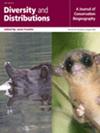Combining eDNA and Visual Surveys Improves Detection of Reef Fishes Across Their Biogeographic Ranges
Abstract
Aim
Rapid shifts in marine species distributions driven by ocean warming require more effective monitoring across entire ranges to detect emerging ecological change. Traditionally, visual surveys have been used to track these distributional shifts, but they often overlook small-bodied, rare or cryptic species, potentially underestimating range changes. Environmental DNA (eDNA) bypasses these limitations, yet its effectiveness in detecting species near their range limits remains understudied.
Location
Eastern Australia.
Methods
We combined eDNA metabarcoding and visual surveys to assess reef fish communities across nine sites spanning a 2000-km latitudinal gradient within a global warming hotspot encapsulating tropical, subtropical and temperate reefs. Variation in detectability across methods and biogeographic ranges was also assessed at the level of functional traits (trophic guild, thermal guild and water column position).
Results
eDNA and visual surveys revealed different fish species compositions, potentially underestimating the extent of fish biogeographic ranges. eDNA detected 44 more unique tropical species than visual surveys across their range, and was more effective at detecting tropical carnivores, omnivores, invertivores, planktivores, detritivores and all water column positions. In contrast, visual surveys were more effective at detecting temperate carnivores, invertivores and benthic species. For tropical fishes at their cold range edge in temperate ecosystems, eDNA identified 12 unique species, including herbivores and cryptic species not previously recorded by long-term visual surveys. Contrastingly, eDNA detected 20 fewer temperate species than visual surveys across their biogeographic range and was less effective (five unique species) than visual surveys (nine unique species) at detecting temperate species at their warm trailing range in subtropical ecosystems.
Conclusions
Combining eDNA and visual surveys improves the detection of reef fishes near the limits of their known distributions. This approach helps reveal overlooked species, particularly those that are cryptic, rare or low in abundance, and supports more accurate assessments of species distributions across biogeographic gradients.


 求助内容:
求助内容: 应助结果提醒方式:
应助结果提醒方式:


